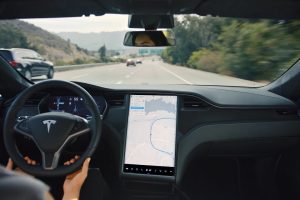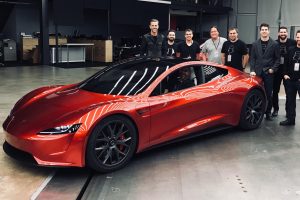In the summer of 2006, a little-known startup named Tesla Motors jumpstarted the modern-day electric vehicle industry. At the time, most people equated electric vehicles with golf carts: slow, clunky, and with limited functionality. GM had just scrapped its pioneering EV1, as chronicled in Chris Paine’s 2006 documentary Who Killed the Electric Car?, and it seemed like the future of high-efficiency cars was going to be cars that looked a lot like the fast-selling Toyota Prius.
That is what made the debut of the Tesla Roadster revolutionary. On July 19, 2006, Tesla rolled out the Roadster at an invitation-only event at an airport hangar in Santa Monica, California. Not only was it a sleek sports car, it could go 250 miles on a single charge, it could accelerate from zero to 60 mph in less than four seconds, and it was silent. This was no golf cart. As one reporter commented, the Roadster made clear the “endless possibility out there in electric motor land.”
Even then, Tesla had plans that went far beyond the Roadster. Two weeks later, Elon Musk posted the “Secret Tesla Motors Master Plan,” which outlined Tesla’s ambition to leverage sales of the high-end Roadster to build a “wide range of models, including affordably priced family cars.”
I expect many readers of CleanTechnica already know this story, which is part of my new book, Charged: A History of Batteries and Lessons for a Clean Energy Future, but what I didn’t appreciate about this story until I researched the book is just how inauspicious the timing of the Roadster’s debut was. In the summer of 2006, the power of lithium-ion batteries had begun to draw public attention for a very different reason: they kept catching on fire.
Back in the early 2000s, few people knew what a lithium-ion battery was, even though they were quickly replacing the nickel-metal hydride batteries that had been used to power an earlier generation of cell phones, laptops, and other electronic devices. But public awareness of lithium-ion batteries grew rapidly in 2006 as sporadic reports of laptop fires in hotels, airports, cars, and homes drew increasing public attention. The culprit? Lithium-ion battery packs manufactured by Sony, which were used by manufacturers such as Dell, Apple, and IBM.
Although the fires were rare, considering the tens of millions of laptops in production, they were common enough that in August 2006, in cooperation with the US Consumer Product Safety Commission, Sony initiated a worldwide recall of the lithium-ion battery packs it had manufactured for use in notebook computers since 2005. At the time, it was the largest consumer electronics product recall in American history. The best article on the recall and its roots in the globalization of the electronics industry is Matthew Eisler’s 2017 article in Technology and Culture.
An op-ed published in the New York Times in August 2006 was one of many pieces that raised the alarm over lithium-ion batteries. It warned: “Lithium-ion is just the latest in a succession of relatively toxic rechargeable battery technologies, each intended to pack more available electrons in smaller and smaller packages, with li-ion besting the field by a resounding five times, explosions be damned.”
Not only did the Roadster rely on similar battery cells, it relied on a lot of them. The Roadster’s battery pack contained 6831 laptop-grade 18650 lithium-ion battery cells. But Tesla’s engineers did not see the laptop fires as cause for alarm. “There have been five laptop fires so far and it’s front-page news,” Ian Wright, Tesla’s first head of vehicle development, told Vanity Fair. “There are 750 gas-car fires each day, but that’s not news.”
To assure observers of the safety of its battery pack, Tesla took an unusual step in August 2006 for a vehicle that was still a year from delivery. It released a 5-page document outlining its strategy for building a safe and resilient electric vehicle battery pack using consumer-grade lithium-ion battery cells. The paper outlined the active and passive safety features engineered into the battery system. Tesla explained how using thousands of small batteries, as opposed to fewer large battery cells, improved safety by increasing heat dissipation and making it easier to contain any cell failures.
With laptop batteries going up in flames, manufacturers issuing recalls, and lithium-ion batteries making the headlines for all the wrong reasons in 2006, it is little surprise that big automakers weren’t ready to bet that the same technology that had enabled the wireless revolution could power a transition to electric cars. The early hybrid cars, including the Toyota Prius, relied upon the lower-performing, but safer, nickel-metal hydride batteries. That made Tesla’s bet on the Roadster all more the audacious. And, in retrospect, it is clear that bet paid off.
This post is adapted from James Morton Turner’s new book, Charged: A History of Batteries and Lessons for a Clean Energy Future (August 2022). You can learn more about Charged via the link above. Turner tweets at @_jay_turner





